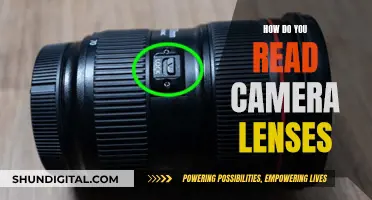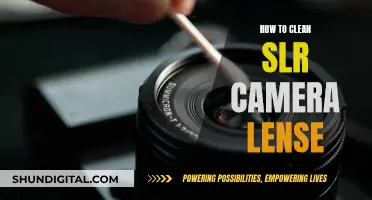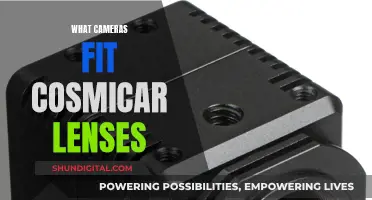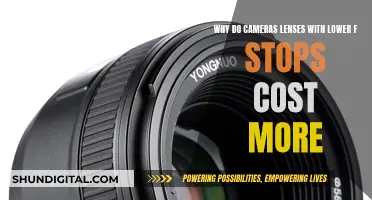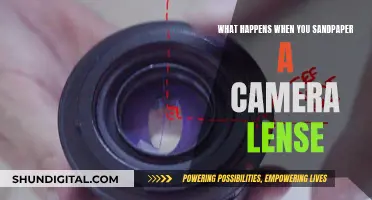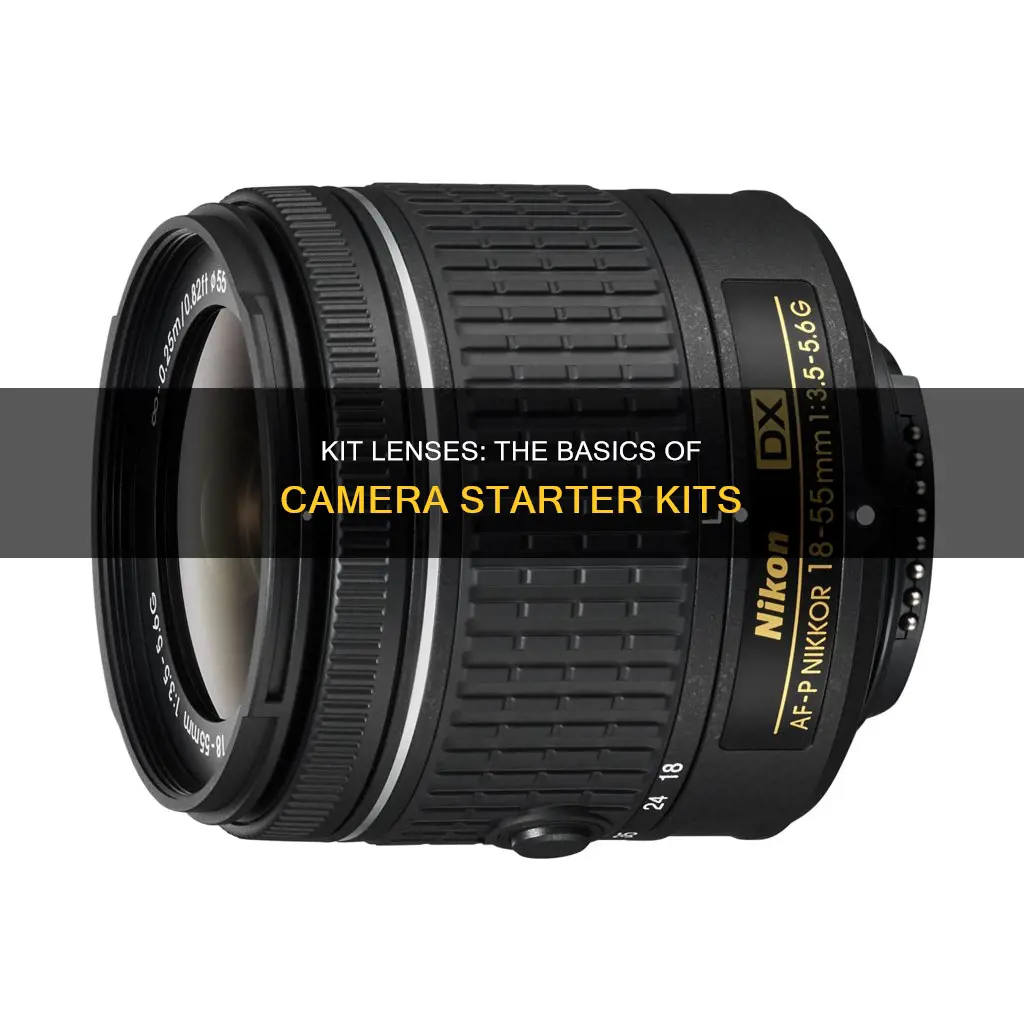
Kit lenses are starter lenses that are sold with an interchangeable-lens camera, such as a mirrorless camera or DSLR. They are usually inexpensive and are priced at the lower end of the manufacturer's range so that they do not add much to the cost of the camera kit. Kit lenses are typically bundled with the camera body, the lens, and various accessories. They are ideal for beginners as they are versatile, lightweight, and convenient. However, they may not produce sharp images and are made with cheaper materials.
| Characteristics | Values |
|---|---|
| Type | Interchangeable lens that comes bundled with a camera |
| Price | Inexpensive |
| Focal length | Usually 18-55mm, but can be longer |
| Aperture | Variable |
| Weight | Lightweight |
| Use | Beginner photographers |
What You'll Learn

Kit lenses are usually bundled with a camera
Kit lenses are versatile and convenient. They are usually zoom lenses that cover the most commonly used focal lengths, making them ideal for a range of different shooting situations. They are also compact and lightweight, making them a handy addition to your camera bag.
Kit lenses are also a great way to learn about photography and your camera. They allow you to get shooting straight away and experiment with different focal lengths and apertures before investing in more expensive lenses.
However, kit lenses do have some limitations. They are usually cheaply made with plastic instead of metal, and the image quality may not be as sharp as more expensive lenses. They also tend to have variable apertures, which can be confusing for beginners, and they may not perform as well in low light conditions.
Overall, kit lenses are a great option for beginners who want to get started in photography without spending a lot of money. They offer versatility, convenience, and the opportunity to learn and experiment before investing in more specialised lenses.
Traveling with Camera Lenses: A Comprehensive Guide for Photographers
You may want to see also

They are versatile
Kit lenses are versatile. The most common kit lens is the 18-55mm lens, which is a zoom lens that covers a range of focal lengths from wide-angle to short telephoto. This makes it ideal for a variety of shooting situations, such as landscape, street, and portrait photography.
The 18-55mm focal length range is perfect for capturing expansive scenes, such as landscapes or beaches, as well as for taking close-up portrait shots. With this kit lens, you can shoot at a wide angle of 18mm, giving you a wide view of your scene, or zoom in to 55mm for a closer and more narrow view.
The versatility of kit lenses allows photographers to experiment with different focal lengths and find their preferred shooting style. For example, you might discover that you enjoy shooting at wider angles for landscapes or that you prefer the compressed perspective of portrait photography.
Additionally, kit lenses are often bundled with camera bodies, making them an affordable option for beginners who want to explore different focal lengths without investing in multiple lenses. The 18-55mm kit lens is a great starting point for beginners as it offers a good balance between price and performance.
While kit lenses may not offer the same optical quality as more expensive lenses, they provide an excellent opportunity to learn and develop your photography skills before investing in specialised lenses. They are lightweight, convenient, and versatile, making them a popular choice for those starting their photography journey.
The Myth of Camera Lenses: Curved Glasses Explained
You may want to see also

They are lightweight
Kit lenses are lightweight and portable, making them ideal for beginners who are still getting used to carrying their DSLR and mirrorless cameras around. They can be as light as 7 oz. or 200g. Their compact size and weight make them the perfect first lens to own as you get to grips with your new camera. They are also handy to have when travelling or for everyday use.
Kit lenses are also versatile. They tend to be zoom lenses, usually with a focal length ranging from wide-angle to short telephoto. This makes them really versatile for a range of different shooting situations. The 18-55mm kit lens, for example, covers the wide-angle focal length (perfect for landscapes) up to 55mm (a focal length that can be used for portrait photography).
Kit lenses are also convenient. When you invest in a new camera system, you can start shooting with it straight away. You can continue to plan your full arsenal of prime and zoom lenses for your camera while shooting across a varied focal range.
Kit lenses are also affordable. While they won't be the most high-quality lens you can buy for your new camera, manufacturers bundle them with their cameras for a very affordable price. This means you can start shooting and getting to know your camera while you save up for other lenses.
Motorized Telescoping Lenses: Are They Reliable Camera Companions?
You may want to see also

They are ideal for beginners
Kit lenses are ideal for beginners. They are bundled with the camera, so you can start shooting straight away. They are also inexpensive, so they are a good option for those who are just starting out and don't want to invest a lot of money in their first camera and lens. Kit lenses are also versatile, covering a range of focal lengths, which means you can experiment with different types of shots, from expansive landscapes to close-up portraits. This versatility also means you can road-test focal lengths before investing in more lenses.
Kit lenses are usually small and lightweight, which makes them ideal for beginners who are getting used to carrying around their camera. They are also convenient, as they allow you to get out and start shooting with your new camera right away.
Kit lenses are also a good way to learn about photography and your camera before investing in more expensive lenses. You can learn about your camera menu, and how to use shutter speed and focal length, without spending a lot of money.
Kit lenses are not known for producing fantastic photos, and they do have limitations. They are not known for being sharp, and they have variable apertures, which can be confusing for beginners. They are also cheaply made, so they are not built to last. But, for a beginner, a kit lens is a great way to get into DSLR photography.
Protecting Your Camera Lenses: Tips for Longevity
You may want to see also

They are inexpensive
Kit lenses are typically inexpensive, entry-level lenses that come bundled with a camera. They are usually priced at the lower end of the manufacturer's range to keep the overall cost of the camera kit down.
Kit lenses are often seen as a "starter" lens, ideal for beginners who are just starting out with DSLR photography. They are a budget-friendly option for photographers who are new to the field or those who don't have a lot of money to spend. While they may not offer the best image quality or durability, they are perfect for learning the basics of photography and getting to know your camera.
The affordability of kit lenses allows photographers to start shooting right away without having to invest a lot of money upfront. This is especially beneficial for those who want to get a feel for photography before committing to more expensive equipment. With a kit lens, you can start experimenting with different focal lengths, apertures, and shooting scenarios to find what works best for you.
Additionally, the compact size and lightweight design of kit lenses make them convenient for travel and everyday use. They are easy to carry around and allow you to capture moments without being weighed down by bulky equipment. The versatility of kit lenses, with their variable focal lengths, also means you can adapt to different shooting situations without needing multiple lenses.
While kit lenses may not offer the same level of performance as more expensive lenses, their low price point makes them a practical choice for beginners or those on a budget. They strike a balance between functionality and affordability, providing an accessible entry point into the world of photography.
Camera Lenses: Understanding the Basics of Photography
You may want to see also
Frequently asked questions
A kit lens is a "starter" lens that is usually bundled with an interchangeable-lens camera, such as a DSLR or mirrorless camera. It is typically inexpensive and priced at the lower end of the manufacturer's range to keep the overall cost of the camera kit down.
Kit lenses are versatile, lightweight, and convenient for beginners to get started with photography. They are also affordable, allowing users to learn and explore before investing in more expensive lenses.
Kit lenses may have limited aperture ranges, variable apertures, and inferior image and optical quality compared to higher-end lenses. They are also typically made of cheaper materials and may not be as durable.
The 18-55mm lens is a common kit lens that offers a range of focal lengths, from wide-angle to short telephoto, making it versatile for different types of photography.
Kit lenses are great for beginners, but as your skills develop and you find the limitations of the kit lens, you may want to upgrade to a higher-quality lens. This could be a prime lens, such as a 50mm lens, or a more specialized lens depending on your photography needs.


